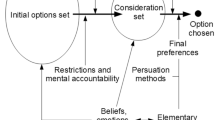Abstract
Webstores can easily gather large amounts of consumer data, including clicks on single elements of the user interface, navigation patterns, user profile data, and search texts. Such clickstream data are both interesting to merchandisers as well as to researchers in the field of decision-making behavior, because they describe consumer decision-behavior on websites. This paper introduces an approach that infers decision-behavior from clickstream data. The approach observes clicks on elements of a decision-support-system and triggers a set of state-machines for each click. Each state-machine represents a particular decision-strategy which a user can follow. The approach returns a set of decision strategies that best explain the observed click-behavior of a user. Results of two experiments show that the algorithm infers strategies accurately. In the first experiment, the approach correctly infers most of the pre-defined decision-strategies. The second study analyzes the behavior of thirty-eight respondents and finds that the inferred mix of decision-strategies fits well the behavior described in the literature to date. Results show that using decision-support-systems on a web site and observing the user’s click-behavior make it possible to infer a specific decision strategy. The proposed method is general enough to be easily applied to both research and real-world settings, along with other decision-support-systems and strategies.







Similar content being viewed by others
References
Böckenholt U, Albert D, Aschenbrenner M, Schmalhofer F (1991) The effects of attractiveness, dominance, and attribute differences on information acquisition in multiattribute binary choice. Organ Behav Hum Decis Process 49(2):258–281
Beach L (1990) Image theory: decision making in personal and organizational contexts. Wiley, Chichester
Bettman J, Johnson E, Payne J (1990) A componential analysis of cognitive effort in choice. Organ Behav Hum Decis Process 45(1):111–139
Bettman J, Johnson E, Luce M, Payne J (1993) Correlation, conflict, and choice. J Exp Psychol Learn Mem Cogn 19:931–951
Bettman J, Park, C (1980) Effects of prior knowledge and experience and phase of the choice process on consumer decision processes: a protocol analysis. J Cons Res 7: 234–248
Bröder A, Schiffer S (2003) Bayesian strategy assessment in multi-attribute decision research. J Behav Decis Mak 16:193–213
Eisenfuhr F, Weber M (2002) Rationales Entscheiden. Springer, Berlin
Evans PF, Camus L, Sehgal V, McGowan B (2010) Western European Online Retail Forecast, 2009 to 2014, Forrester Research. http://www.forrester.com/rb/Research/western_european_online_retail_forecast%5C%2C_2009_to/q/id/56543/t/2. Accessed 9 July 2011
Fasolo B, Misuaraca R, McClelland G (2003) Individual differences in adaptive choice strategies. Res Econ 57(3):219–233
Ford JK, Schmitt N, Schechtman SL, Hults BM, Doherty ML (1989) Process tracing methods: contributions, problems, and neglected research questions. Organ Behav Hum Decis Process 43(1):75–117
Garbarino EC, Edell JA (1997) Cognitive effort, affect, and choice. J Cons Res 24(2):147–158
Gilbride T, Allenby G (2004) A choice model with conjunctive, disjunctive, and compensatory screening rules. Marketing Sci 23(3):391–406
Gilbride T, Allenby, G (2006) Estimating heteroogeneous eba and economic screening rule choice models. Marketing Sci 25(5):494–509
Gupta P, Yadav MS, Varadarajan R (2009) How task-facilitative interactive tools foster buyers’ trust in online retailers: a process view of trust development in the electronic marketplace. J Retail 85(2):159–176
Harte JM, Koele P (2001) Modelling and describing human judgement processes: the multiattribute evaluation case. Think Reason 7(7):29–49
Hogarth R (1987) Judgment and choice, 2nd edn. Wiley, Chichester
Hopcroft JE, Motwani R, Ullman JD (2006) Introduction to automata theory, languages, and computation, 3rd edn. Addison-Wesley Longman Publishing Co, Inc, Boston
Keeney R, Raiffa H (1993) Decisions with multiple objectives: preferences and value tradeoffs, 14th edn. Wiley
Klein NM, Yadav MS (1989) Context effects on effort and accuracy in choice: an enquiry into adaptive decision making. J Cons Res 15(4):411–421
Lohse G, Johnson EA (1996) Comparison of two process tracing methods on choice tasks. Organ Behav Hum Decis Process 68(1):28–43
Luce MF, Bettman JR, Payne JW (1997) Choice processing in emotional difficult decisions. J Exp Psychol Learn Mem Cogn 23(2):384–405
Olshavsky R (1979) Task complexity and contingent processing in decision making: a replication and extension. Organ Behav Hum Perform 24:300–316
Payne J (1976) Task complexity and contingent processing in decision making: an information search and protocol analysis. Organ Behav Hum Perform 16(2):366–387
Payne J, Bettman J, Johnson E (1988) Adaptive strategy selection in decision making. J Exp Psychol Learn Mem Cogn 14(3):534–552
Payne J, Bettman J, Johnson E (1993) The adaptive decision maker. Cambridge University Press, Cambridge
Pfeiffer J, Duzevik D, Rothlauf F, Yamamoto K (2009a) A genetic algorithm for analyzing choice behavior with mixed decision strategies. In: G. Raidl (ed) Proceedings of the Genetic and Evolutionary Computation Conference, Montreal, Canada ACM Press
Pfeiffer J, Riedl R, Rothlauf F (2009b) On the relationship between interactive decision aids and decision strategies: a theoretical analysis. In: Hansen HR, Karagiannis D, Fill H-G (eds) Proceedings of the 9th internationale Tagung Wirtschaftsinformatik
Pfeiffer J, Vogel F, Stumpf S, Kiltz, CA (2010) A theory-based approach for a modular system of interactive decision aids. In: Proceedings of the 16th Americas Conference on Information Systems (AMCIS)
Pfeiffer J, Meißner M, Brandstätter E, Riedl R, Rothlauf F (2012) The influence of context-based complexity in CBC choice tasks. Technical report, University of Mainz, University of Bielefeld, University of Linz
Reisen N, Hoffrage U, Mast FW (2008) Identifying decision strategies in a consumer choice situation. Judgm Decisi Mak 3(8)641–658
Riedl R, Brandstätter E, Roithmayr F (2008) Identifying decision strategies: A process and outcome-based classification method. Behav Res Methods 20(3):795–807
Russo J, Dosher B (1983) Strategies for multiattribute binary choice. J Exp Psychol Learn Mem Cogn 9(4):676–696
Russo J, Johnson E, Stephens D (1989) The validity of verbal protocols. Mem Cogn 17:759–769
Russo J, Leclerc F (1994) An eye-fixation analysis of choice processes for consumer nondurables. J Consum Res 21(2):274–290
Russo J (1978) Eye fixations can save the world: a critical evaluation and a comparison between eye fixations and other information processing methodologies. In: Hunt HK (ed) Advances in Consumer Research, Vol 21. Association for Consumer Research, Ann Arbor, pp 561–570
Svenson O (1979) Process descriptions of decision making. Organ Behav Hum Perform 23:86–112
Todd P, Benbasat I (1991) An experimental investigation of the impact of computer based decision aids on decision making strategies. Inf Syst Res 2:87–115
Todd P, Benbasat I (1992) An experimental investigation of the impact of computer based decision aids on processing effort. MIS Q 16(3):373–393
Todd P, Benbasat I (1994) The influence of decision aids on choice strategies und conditions of high cognitive load. IEEE Trans Syst Man Cybern 24(4):537–547
Tversky A (1969) Intransitivity of preferences. Psychol Rev 76:31–48
Tversky A (1972) Elimination by aspects: a theory of choice. Psychol Rev 79:281–299
Author information
Authors and Affiliations
Corresponding author
Appendix
Appendix
DIS (disjunctive rule):
The decision maker uses an alternative-wise approach The alternative that satisfies the aspiration level for at least one relevant attribute is selected If several alternatives fulfill this criterion, one of them is selected at random.
COM (compatibility rule):
The decision maker uses an alternative-wise approach The alternative that satisfies the aspiration levels onk attributes is selected Parameterk is defined by the decision makerk only defines how many attributes have to meet the aspiration level—the decision maker can consider different attributes for each alternative, as long as the number of considered attributes is equal tok for each alternative. (Note that fork = 1 COM is equal to CONJ.).
SAT (satisficing heuristic):
The decision maker examines all alternatives alternative-wise and selects the first alternative that satisfies all aspiration levels If no alternative satisfies all aspiration levels, nothing is selected.
ADD (additive difference rule):
Attributes are compared two at a time The decision maker evaluates all attributes and attribute levels with utility values The overall utility of an alternative is the sum of all the weighted single utility values A weighted single utility value is defined as the product of the utility value of the attribute level and the utility of the corresponding attribute The utility value of an attribute allows the decision maker to rate some attributes as higher than others The alternative with the highest overall utility value is compared with the next alternative These pairwise comparisons are performed until only one alternative is left.
EQW (equal weights rule):
The utility maximizing alternative is selected The decision maker assigns attribute values to all attribute levels The overall utility of an alternative is the sum of the attribute values The strategy is called ‘equal weight’, since only attribute values vary, but attributes are weighted equally.
SAT + (satisficing plus heuristic):
The decision maker uses an alternative-wise approach in arbitrary order The selected alternative is the one whose attribute levels meet the aspirations levels on all of the most important attributes first.
LED (minimum difference lexicographic rule):
The alternative with the best attribute level for the most important attribute is selected Alternatives that are only marginally worse are accepted If several alternatives are equivalent for this attribute, then the second most important attribute is considered etc.
MAJ (majority rule):
The decision maker defines the best attribute level for each attribute The alternative that has the highest number of better attributes is selected.
Rights and permissions
About this article
Cite this article
Pfeiffer, J., Probst, M., Steitz, W. et al. Inferring decision strategies from clickstreams in decision support systems: a new process-tracing approach using state machines. Z Betriebswirtsch 82 (Suppl 4), 25–46 (2012). https://doi.org/10.1007/s11573-012-0581-0
Published:
Issue Date:
DOI: https://doi.org/10.1007/s11573-012-0581-0




